ornamental shrubs are an adornment of any modern garden. They create hedges, group plantings. A garden in which ornamental shrubs bloom is always amazingly beautiful.
Experienced gardeners prefer to grow several at the same time on their site. various kinds ornamental shrubs that bloom in different time to create a garden of continuous flowering.
In the photo on the left: profusely flowering weigela ( Weigela floribunda(Siebold & Zucc.) K.Koch).
 One of the first, immediately after the snow melts, blooms forsythia or forsythia (Forsythia Vahl). It blooms profusely with beautiful bright yellow flowers in the form of bells. The forsythia bush is completely covered with flowers.
One of the first, immediately after the snow melts, blooms forsythia or forsythia (Forsythia Vahl). It blooms profusely with beautiful bright yellow flowers in the form of bells. The forsythia bush is completely covered with flowers.
Plant height 1-3 meters, width up to 2 meters.
Forsythia is frost-resistant, undemanding to soils, shade-tolerant. Propagated by cuttings.
Forsythia is a primrose shrub. Bright yellow flowers appear on the bare branches of Forsythia long before leaves appear on other trees and shrubs. The leaves on this shrub bloom after flowering.
Immediately after flowering, forsythia must be cut off, otherwise it grows very quickly.
Forsythia was named after the Scottish horticulturist William Forsythe. William Forsyth) (1737-1804), who brought this plant from China to Europe. William Forsythe was the head gardener of Kensington Palace and one of the founders of the Royal Horticultural Society ( Royal Horticultural Society).


 blooms in spring beaver or laburnum (Laburnum Fabr.). This plant is popularly called Golden Rain.
blooms in spring beaver or laburnum (Laburnum Fabr.). This plant is popularly called Golden Rain.
Laburnum is a small tree up to 5-6 meters high.
The flowers are very beautiful, bright yellow, collected in brushes 10-30 cm long. Laburnum flowers resemble butterflies in their shape. It blooms profusely and for a long time, from April to June.
Bobovnik is unpretentious, undemanding to soils and frost-resistant.
It should be remembered that all parts of the laburnum, especially its seeds, very poisonous, therefore, this plant must be handled with extreme care.


Photo: Anneli Salo, Pöllö, Jeffdelonge.
 Golden arch of blooming laburnum at Bodnant Garden, Wales, UK.
Golden arch of blooming laburnum at Bodnant Garden, Wales, UK.
Photo: GerritR.
 genomeles or japonica (Chaenomeles japonica(Thunb.) Lindl. ex Spach) blooms in April-May.
genomeles or japonica (Chaenomeles japonica(Thunb.) Lindl. ex Spach) blooms in April-May.
Shrub 80-120 cm high, often used to create hedges. Has spikes.
The flowers are large, 3-5 cm in diameter, usually bright red, rarely pink or white.
In order for chaenomeles to bloom better, it must be cut off periodically.
Japanese quince fruits ripen in September-October. They are edible, but very sour, while quite fragrant. The fruits can be used to make jams, jams, compotes, etc.
Chaenomeles prefers rich, well-drained soils. Best time for planting April or early October.


 Blooms in late May - early June weigela (Weigela Thunb.).
Blooms in late May - early June weigela (Weigela Thunb.).
This is a very beautiful bush 70-80 cm high, about 1 meter wide. It blooms with pink or purple-red flowers in the form of bells. Differs in plentiful and very beautiful flowering. During flowering, the weigela bush looks like a pink cloud.
Weigela shade-tolerant, used for single or group plantings in the garden, rock gardens, as well as for creating hedges.
Weigela was named after the famous German botanist Christian Ehrenfried von Weigel ( Christian Ehrenfried von Weige), (1748-1831).
Weigela blooming (Weigela florida(Bunge A.D.C.)


 Weigela profusely flowering or weigela floribunda (Weigela floribunda(Siebold & Zucc.) K.Koch)
Weigela profusely flowering or weigela floribunda (Weigela floribunda(Siebold & Zucc.) K.Koch)
Japan, Saitama Prefecture, Musashi Kyuryou National Government Park.
 Blooms from late spring to early summer action (Deutzia Thunb.). This is a low shrub with a height of 50 cm to 1.5 meters. Differs in plentiful and long blossoming. Action flowers are white, pink, purple, purple, often collected in inflorescences. There are varieties of action with double flowers. Unfortunately, deutsia flowers have little or no fragrance.
Blooms from late spring to early summer action (Deutzia Thunb.). This is a low shrub with a height of 50 cm to 1.5 meters. Differs in plentiful and long blossoming. Action flowers are white, pink, purple, purple, often collected in inflorescences. There are varieties of action with double flowers. Unfortunately, deutsia flowers have little or no fragrance.
Deytion shade-tolerant, grows well in the city. It is used for decoration of borders, in group and single plantings.
A bush of action in one place can live up to 25 years.
Most common in horticulture action rough, or stellate (Deutzia scabra Thunb.), imported from Japan and China.


 Blooms in late spring kerria japanese (Kerria japonica DC.). Flowering time from April to June.
Blooms in late spring kerria japanese (Kerria japonica DC.). Flowering time from April to June.
Kerria reaches a height of 1-2 meters. It blooms with golden yellow flowers with 5 petals, shaped like a rose. Kerria flowers reach 5-6 cm in diameter.
For the beauty of the flowers, kerria is sometimes called the "Easter Rose".
Kerria is not demanding on soils, resistant to exhaust gases. Therefore, it is often planted on the roadsides, near the garden fence. Kerria can also be used for vertical gardening. Its stems often climb other plants, walls of houses, fences, rocks.


 Kerria got its name in honor of the Scottish gardener, plant collector and the first gardener of the Royal Botanic Gardens in Ceylon, William Kerr ( William Kerr).
Kerria got its name in honor of the Scottish gardener, plant collector and the first gardener of the Royal Botanic Gardens in Ceylon, William Kerr ( William Kerr).
William Kerr developed a special variety of Japanese kerria Pleniflora. Its flowers are very beautiful, terry. Therefore, this variety of kerria is also called Japanese yellow rose(Japanese Yellow Rose).


Photos: Reggaeman, Jeffdelonge, Ignis and others.
![]() Blooms in July - August hydrangea (Hydrangea L.), with ornamental horticulture the most common hydrangea (Hydrangea arborescens L.). This is a shrub 1-3 meters high with white flowers collected in large inflorescences in the form of balls up to 15 cm in diameter.
Blooms in July - August hydrangea (Hydrangea L.), with ornamental horticulture the most common hydrangea (Hydrangea arborescens L.). This is a shrub 1-3 meters high with white flowers collected in large inflorescences in the form of balls up to 15 cm in diameter.
Hydrangea tree is unpretentious, frost-resistant, prefers fertile acidic soils. It does not tolerate drought well, so it requires regular watering.
 Hydrangea must be systematically pruned: in late autumn after the end of flowering and in early spring, before the leaves appear.
Hydrangea must be systematically pruned: in late autumn after the end of flowering and in early spring, before the leaves appear.
Hydrangea is propagated by cuttings. The best time for planting is the beginning of April.
All parts of the hydrangea are poisonous, so this plant must be handled with extreme care. It cannot be eaten.
 One of the most popular varieties of hydrangea tree "Annabelle" has very large inflorescences, white with a slightly greenish tint.
One of the most popular varieties of hydrangea tree "Annabelle" has very large inflorescences, white with a slightly greenish tint.


 Blooms from June to October shrub cinquefoil or cinquefoil shrub or Kuril tea (Pentaphylloides fruticosa(L.) O.Schwarz). Bush up to 1.5 meters high. One plant can bloom up to 2 months.
Blooms from June to October shrub cinquefoil or cinquefoil shrub or Kuril tea (Pentaphylloides fruticosa(L.) O.Schwarz). Bush up to 1.5 meters high. One plant can bloom up to 2 months.
Kurl tea - medicinal plant, widely used in traditional medicine.
The Kuril hour is a popular ornamental shrub, used for decorating rock gardens, borders, and groups. More than 130 varieties of Kuril tea are known in horticulture. Most cultivars have yellow flowers, as does the wild species. In addition, there are varieties of Potentilla with white, pink, orange and red flowers.
The cinquefoil shrub is unpretentious, frost-resistant, undemanding to soils. You can trim it once every 3 years.


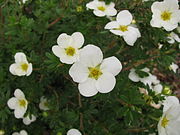 Kuril tea variety "Mckay's White".
Kuril tea variety "Mckay's White".
 Kuril tea variety "Red Ace".
Kuril tea variety "Red Ace".
 Snowberry, snowfield, snow berry or wolfberry (Symphoricarpos Dill. ex Juss.) blooms all summer, from May to September. Depending on the species, its flowers can be white, pink, red. But the snowberry is famous not for its flowers, but for its snow-white fruits in the form of berries with a diameter of about 1 cm, which stay on the bush all autumn and winter, giving it a great decorative effect.
Snowberry, snowfield, snow berry or wolfberry (Symphoricarpos Dill. ex Juss.) blooms all summer, from May to September. Depending on the species, its flowers can be white, pink, red. But the snowberry is famous not for its flowers, but for its snow-white fruits in the form of berries with a diameter of about 1 cm, which stay on the bush all autumn and winter, giving it a great decorative effect.
The snowberry blooms profusely and for a long time. The flowers are small, in the form of bells, 5 mm in diameter, collected in dense racemose inflorescences. Snowberry is a unique shrub, you can see both flowers and fruits on it at the same time.
Shrub height 1-2 meters. It is used to create hedges and in group plantings. Handles haircut well. Unpretentious, winter-hardy, not picky about soils.
The snowberry is poisonous, its berries cannot be eaten.

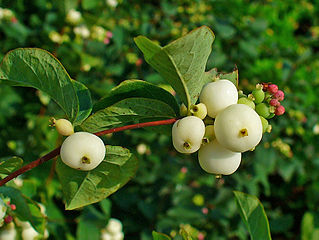
Caring for these ornamental shrubs is not difficult. They are all frost-resistant, they do not need to be covered for the winter (perhaps only young shoots).
Ornamental shrubs propagate by cuttings; they are not demanding on soils.
The only care is that they need to be trimmed periodically to give them a beautiful, regular shape.
These are beautiful, plentiful flowering shrubs will decorate your garden all season - with early spring until late autumn.
In the spring, as soon as the snow melts, the days become longer and the sun brighter, we begin to think about how good it is in nature! But only those who have their own dacha can arrange this corner of nature according to their taste, and even their color. The choice is wide: you can plant lawn flowers, enjoy blooming in spring fruit trees, and of course, flowering shrubs for summer cottages really enliven the atmosphere - and here it is, your place where you can escape from the hustle and bustle of the city and enjoy the silence and smells of wildlife.
Ornamental shrubs can be coniferous, evergreen, such as thuja or juniper. It can be fruit plants, such as raspberries, currants. And there are those that delight and decorate life with bright colors and a delicate smell.
It is incredibly difficult to choose from the endless variety of luxurious flowering wonders of nature, so here are 10 of the most beautiful and popular flowering shrubs for you. middle lane Russia. Almost all are winter-hardy and beautiful in their own way. Surely you can pick one to your liking!
1. Lilac (lat. Syringa)
Probably, there is not a single city, village, town or garden where this lilac splendor would not be fragrant in May! Well, which of us did not look for five petals in childhood? Well, which of us in our youth did not return home with armfuls of fragrant branches? Probably, for all of us, lilac is the most important symbol of spring and the flowering of May. Although in some countries, for example, in England, rich in its traditions landscape design, lilac is unpopular. In this country, bad omens are associated with this flower.
Lilac features:
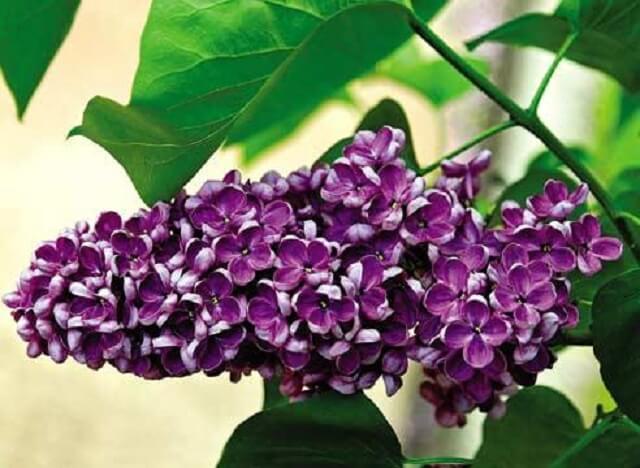
2. Rosehip (lat. Rōsa)
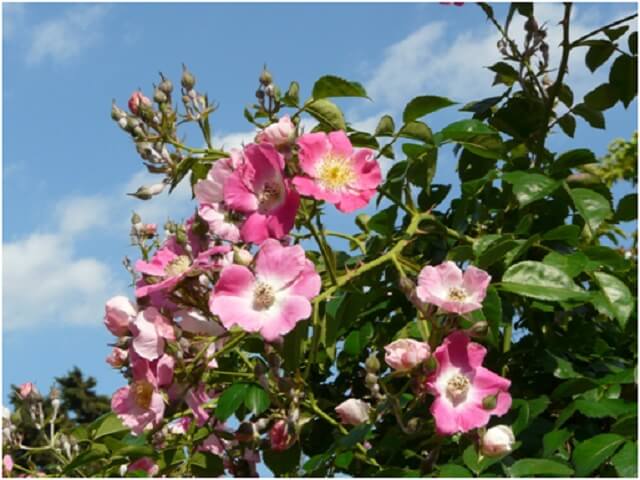
There are a lot of varieties from wild rose to numerous types of garden roses of extraordinary beauty. Starting from the medicine up to the branches winding along the supports, capable of creating arches and galleries. This is not only a flowering, but also a fruiting shrub, the fruits of which are used as a folk remedy.
Rosehip features:

3. Hydrangea (lat. Hydrángea)
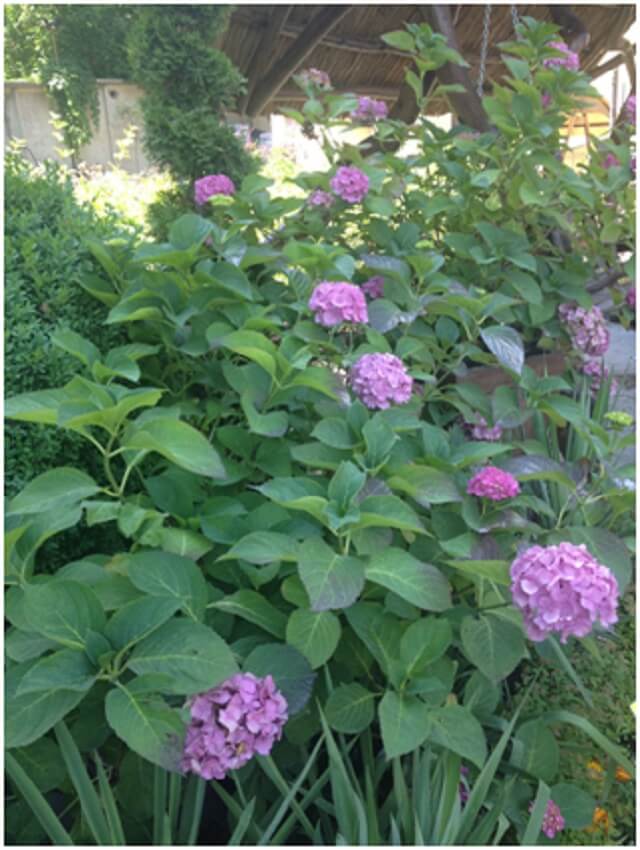
One of the most beautiful perennial garden shrubs. These ornamental flowering shrubs delight the eye with unusually late flowering of lush bright inflorescences.
Hydrangea features:

4. Kalina (lat. Viburnum)

Kalina is a native Russian plant, closely related to folk traditions. These blooming hardy shrubs since ancient times it was considered a symbol of girlish innocence and beauty. Kalina is valuable not so much for its lush white flowering as for its red, tasty and healthy berries.
Viburnum features:
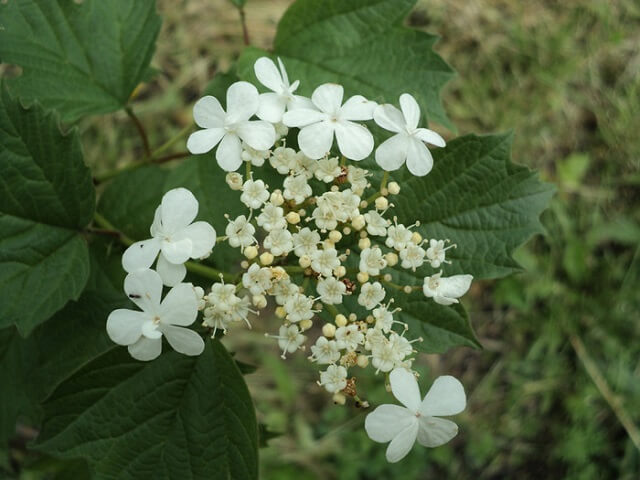
5. Chubushnik (lat. Philadelphus)

Mock orange, which is also called garden jasmine for its resemblance and strong characteristic smell. However, this is a different plant. The name comes from the word "chubuk", in the old days, chibouks for smoking pipes were made from shrub wood.
Chubush features:

6. Spiraea (lat. Spiraea)
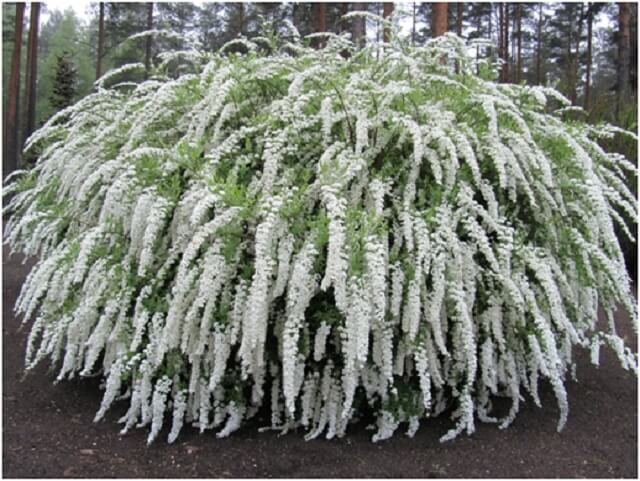
There are spring-flowering and summer-flowering varieties of spirea. With skillful care, shrubs bloom all summer.
Spirea features:
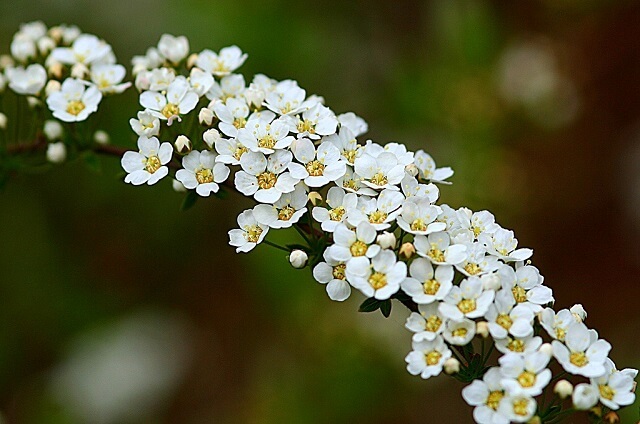
7. Rhododendron (lat. Rhododendron)

A close relative of the room azalea. The leaves of some varieties may remain green all winter. "Stranger" in Central Russia, therefore, requires special care.
Features of rhododendron:
- flowers: white, red, orange, yellow, purple, pink, lilac. Large;
- flowering time: May-June, but some varieties re-bloom in the fall;
- can be both dwarf varieties and in the form of trees several meters high;
- not frost-resistant;
- prefers shade and moisture.
 Rhododendron. Flowers up close.
Rhododendron. Flowers up close. 8. Forsythia (lat. Forsythia)

She's a forsythia. very unusual and beautiful shrub. A symbol of early spring in many European cities, because when none of the trees are in bloom yet, bright sunny flowers appear. And the leaves appear only when the shrub fades. And in autumn, when the leaves turn purple, the shrub again pleases the eye.
Forsythia features:
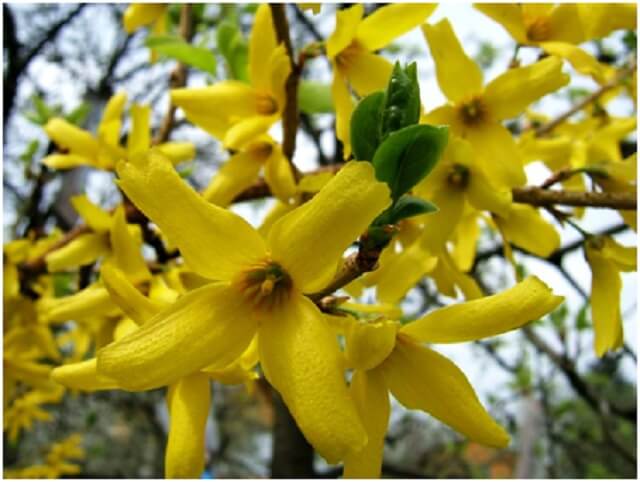
9. Honeysuckle (lat. Lonicera)

Another perennial shrub, both ornamental and fruitful. Blue berries are slightly bitter, but appear relatively early. True, there are some types of honeysuckle that are grown only to decorate the garden, their fruits are inedible.
Honeysuckle Features:

10. Heather (lat. Calluna vulgáris)
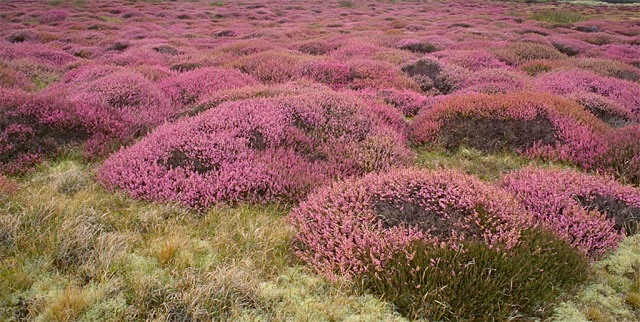
Another perennial shrub with which many legends and stories are associated. A special place in the culture of the British peoples. Allegedly, the heather was the only one who agreed to grow on the barren rocky slopes of the hills, for which he was awarded by the gods with beautiful flowers and the qualities of a honey plant. Heather honey can be brewed in autumn, flowering occurs at the end of summer and the beginning of autumn. In many Slavic languages, the name of the month of September has been preserved - Veresen. This undersized shrub creeping along the ground pleases the eye with flowering until late autumn. And even dry heather flowers are beautiful.
Heather Features:
- flowers: white, pink in various shades to dark purple;
- flowering time: August-September;
- shrub low, creeping along the ground;
- grows well on rocky soil;
- unpretentious to lighting, but in shady places heather flowers become pale.
 Heather. Flowers up close.
Heather. Flowers up close. Plant flowering shrubs in the country to decorate the yard, fill it with a pleasant aroma! Some of these shrubs can also be used as a hedge (fence).
Gardens and dachas of the new wave are stylish cottages, with a comfortable area for citizens to relax, surrounded by beautiful landscape. A traditional dacha, the main function of which is to harvest, also necessarily includes a recreation area., lovingly decorated by the owners. It is for the spectacular design of the backyard territory, a beautiful lawn, a playground for children, that ornamental plants and trees are needed, which are worth talking about in detail.
In addition to the natural aesthetic function - to give a person enjoyment of the beauty of nature, ornamental trees and shrubs are used by gardeners and designers to solve purely practical problems. Visual expansion of too narrow, or very small area. Decorating outbuildings, strengthening slopes and screes. Zoning of the site, the creation of dividing screens between the garden and the backyard area. Protection of the individual space of a small cottage from prying eyes, without erecting a fence.
Popular ornamental trees in the garden and in the country
The current trend in gardening is a beautiful, fruit-bearing garden that does not require huge physical costs to care for and maintain decorativeness. The priority is the beauty and unpretentiousness of trees; the practical benefits of plantings fade into the background. This explains the popularity of new forms of fruit and forest trees, represented by modern breeding.:
- compact standard trees with a spherical crown;
- dwarf forms fruit and forest trees;
- weeping forms;
- columnar hybrids familiar trees.
An interesting novelty is the use of forest trees to decorate a summer cottage. For example, hornbeam seedlings are sold by nurseries at bargain prices. Hornbeam is great for creating hedges, decorative backdrops and walls.

To create spectacular compositions, edging lawns, trees of different heights are used.:
- tall (up to 6 m);
- medium tall (up to 3 m);
- stunted and dwarf trees (up to 1.5 m).
A backdrop is formed from tall trees(wall, or focal point), which is complemented by trees and shrubs below. The foreground of the composition is formed from undersized ones. Trees can be decorated with gravel, located on an open lawn, solo, or combined into relief, multi-tiered groups.
The highest ones land in the background, then the middle ones. Low-growing trees and shrubs are located in front.
Recognized leader - coniferous trees
Mature plants require virtually no maintenance. Coniferous plants are decorative all year round, including winter. At the beginning of spring, many species bloom with bright lilac candles, reminiscent of Christmas decorations.. Then comes the time of active growth, the young shoots are much brighter than last year's branches. During this period, all coniferous trees look especially elegant.

Spruce grows well on swampy soils, this is especially true for the Moscow region. Pine is drought-resistant, tolerates pruning well, which allows you to vary the height and decorative shape. For low hedges, walls, yew can be recommended. The yew keeps its shape perfectly, it does not require significant pruning.
Tui
An unpretentious thuja can be safely chosen as the main decorative element of the garden, which will unite the plantings with a single design. Tui of different varieties will fit perfectly into the composition with undersized shrubs, variegated and flowering trees.
In the nursery, you can pick up varieties of pyramidal, elliptical, or spherical shape. The garden wall of thuja planted in a smooth line looks very interesting. This allows you to unusually beat even a standard suburban area.
For the middle lane, varieties and hybrids of Western thuja are recommended. The unpretentious variety Brabant is suitable for forming a wall, backstage. A single thuja will grow wide, a close planting of a thuja (after 0.5 m) will form a too low wall. The optimal distance between seedlings of the Brabant variety is 1 m. An interesting variety is Wagner's thuja, which has a rounded shape, shorter. Thuja is very fond of showering, spraying, sprinkling.
decorative maples
most popular maple Canadian, Sycamore, Holly maple with burgundy foliage. They perfectly solo on an open lawn, are good in compositions and against the backdrop of hedges.
Maple Holly or Sycamore Burgundy
Like most plants with brightly colored leaves, ornamental colored maples prefer a sunny location. In the shade, the natural color will be faded.. Maple prefers fertile soil, with neutral acidity. Young seedlings should be covered for the winter. mature plant a frost-resistant variety will no longer require this.
Exotic for lovers
Magnolia
It can be formed as a bush, but a full-fledged tree with a picturesque crown can grow. Blooming magnolia is an exotic sight, most varieties have a delicate, vanilla-citrus aroma.. Magnolia is strewn with large flowers (bud length up to 12-15 cm). The color scheme and the shape of the opened flower in different varieties of magnolia differ very dramatically.

The capriciousness of magnolia is greatly exaggerated; for successful cultivation, it is enough to follow a few rules. When planting magnolia Special attention should be given to the root system and the choice of landing site. It is necessary to buy magnolia with a root ball (in a plastic container), preferably in a nursery or garden center. When planting, try not to injure the roots of the seedling. Magnolia loves the bright sun very much, does not tolerate drafts and winds. The optimal landing site is under the southern wall of the house, any outbuilding. Does not like calcareous soils, so such lands must be acidified with peat. Care for an adult plant is not required, only minimal sanitary pruning. For cultivation in gardens of the middle lane, deciduous forms of magnolia are recommended, and the corresponding hybrids.
Young seedlings, even frost-resistant varieties, should be covered for the winter (mulch the roots and cover the crown with agrofiber).
Sakura
A Japanese relative of the familiar cherry, famous throughout the world for its magical flowering. The conditions for growing sakura and magnolia are identical. Sunny place without drafts; neutral or slightly acidic soil. Like ordinary cherries, sakura will need seasonal spraying from pests, abundant watering, and significant pruning.

It is not necessary to buy sakura, it reproduces well by cuttings. This is much cheaper than buying a seedling. In August, the stalk is grafted onto a traditional cherry (or cherry) using the budding method (eye, kidney).
Decorative forms of fruit trees
The apple tree familiar to everyone has many decorative subspecies that bloom more abundantly than simple apple trees. Blooming with scarlet flowers, Ola's apple tree is simply flooded with flowers so that branches are not visible..
Ola apple blossom
Ornamental varieties are grown in the usual agricultural practices, familiar to gardeners for the care of apple trees of traditional varieties. Fruits - small (paradise) apples adorn the garden until late autumn. Yellow, red, purple - look great on the branches. They attract birds to the garden modern version natural solution to pest problems. Paradise apples make original jam. Particularly interesting are the weeping forms, with a variegated and colored leaf.
Decorative shrubs in landscape design
Shrubs in the garden technically perform the natural function of the undergrowth. From an aesthetic point of view, shrubs harmoniously complement garden trees and flower beds acting as a middle manager. This is an extensive class of diverse plants, let's focus on especially popular species.
Junipers: type and variety of bushes
Emphasized decorative, a wide variety of forms and varieties, the name of the most common is given below. By releasing phytoncides, junipers significantly purify the air. In sunny weather, a healing aroma hovers near such a plant.. A common plus of junipers is frost resistance. Bath lovers will need young juniper twigs, which are added to bath brooms for aroma.
Variegata
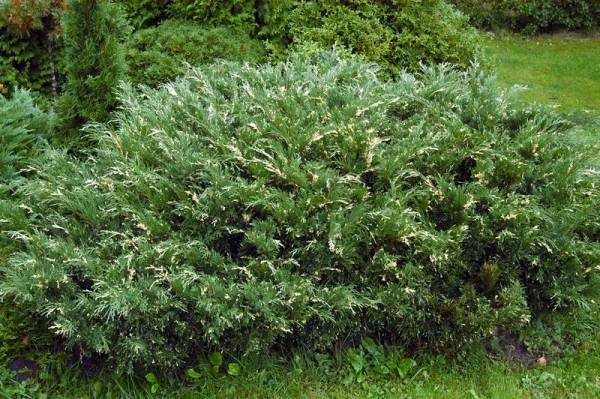
Recognized varieties include juniper Variegata. Flat, with scaly azure needles, and contrasting sand tassels at the end. The shrub is shade-tolerant, but in a sunny place, the decorative tassels of Variegata will be brighter. An adult plant in a sufficient area will look like a lush flower bed.
Cossack

An unpretentious plant of smoky color, prefers light soils, looks great in composition with variegated hostas, ordinary and tree peony. Loves loosening and sprinkling branches. When transplanting, the pit should be 2 times larger than the root ball. Junipers do not resist pruning, although they do not need mandatory pruning.
Between the bushes of the Cossack juniper should be at least 1 - 1.5 meters. In adulthood, it is a spreading, lush bush.
Rock Sky Rocket

Tall Blue Juniper - Rocky Sky Rocket. In diameter up to 1 meter, in height up to 7 meters. It looks like a slender tree, vaguely reminiscent of cypress.
glauka

Low juniper Glauka (up to 30 cm), can grow up to 3 meters wide. The powerful root system of this plant allows you to strengthen the slopes if necessary. This is a suitable plant for the foreground of a garden composition.
Mint Juliet

The fastest growing medium juniper - Mint Julit, reaches 3.5 m in width, up to 1.5 m in height. Blue Carpet is an active aggressor, it occupies a vast area. Reacts to pruning with increased growth. This must be taken into account when landing, but you can use it for your own purposes.
Barberry - add bright accents
The interesting shape of the bush, delicate branches, bright foliage inherent in various varieties, allows the barberry to lead among the colored shrubs. Blooms actively in spring. The crown is purple, red, lilac, lettuce in summer, incredibly transformed in autumn. This is a real carnival of colors, from lemon to wine-colored foliage, scarlet clusters of fruits. Barberry berries are an excellent seasoning for pilaf and meat dishes.

Barberry looks great in single and group plantings. A front garden, an alpine hill, a clearing edging - all these compositions will successfully complement the barberry of the variety and color you like. Barberries of different heights (from 30 cm to 1.5 m) can be interestingly beaten in a prefabricated mixborder. Barberry Thunberg is good in combination with conifers. Undersized pillow-shaped barberry Green Carpet is used for rocky compositions in the Japanese style.
It develops well in an open, sunny place, not picky about soils. Does not tolerate stagnant soil input, when planting a barberry, a high-quality drainage cushion should be provided.

Low growing shrub (up to 80 cm) in looks very exotic, blooms profusely with orange-red flowers. In summer and autumn, it is decorated with fruits resembling heavenly apples. Used for flower beds and rose gardens.
Japanese quince grows well on light sandy soils, loves lighted places. An excellent jam is made from the fruits of the hostess.
Red viburnum
A habitual shrub that never ceases to delight with its beauty and useful berries. Viburnum is very good in color, in autumn it turns crimson - yellow, red clusters of berries glow in the sun.

Kalina loves shady places, the bush can grow quite extensively. This property of viburnum can be successfully used for decorating outbuildings, blank walls of sheds. He likes good watering, the land for planting is mixed with humus (1 × 1). The ground under the viburnum bush should be mulched with tree bark, this will help the moisture-loving plant to develop.
It grows wild in central and southern Europe, in North Africa, in the European part of Russia, mainly in its middle part and in Asia Minor. Rarely found in the west and north of Russia. Kalina can be found in Central and Western Siberia, as well as in the eastern and northern regions of Kazakhstan. Viburnum vulgaris does not grow in Central Asia and the Far East.
Familiar in indoor forms, the large-leaved garden hydrangea is a godsend for lovers of bright, actively flowering plants. Large inflorescences (12-15 cm) bloom in July, remain on the branches until autumn. An adult wisteria bush is not high (up to 1 m), it can reach two meters in diameter, this must be taken into account when planting. Large inflorescences are white, greenish, crimson, pink and even blue.

Hydrangea loves well-lit places, but direct sunlight is harmful to her. You will need moist, slightly acidic soil, abundant watering, top dressing. When planting, peat, sand, coniferous forest soil are added to the earthen mixture. Feeding the hydrangea with iron preparations, amateurs achieve a bright blue color of the inflorescences from the hydrangea.. It is advisable to mulch the near-trunk circle with needles, use slightly acidified water for irrigation. For the winter, the hydrangea should be covered.
Interesting novelty: columnar fruit trees
Compact, productive trees, studded with fruits of the usual size, have fascinated many gardeners. The columns bear fruit already in the second year, take up little space, it is convenient to care for them.. The life span of such a tree is up to 15 years, in contrast to the usual longevity of ordinary fruit and stone fruit trees.
What are columnar trees
Columnar apple tree - undersized, dwarf (relative to the standard) standard tree. Proven, high-quality varieties - Arbat (red apple of medium ripening), Bolero (winter), Jin (summer variety).
On sale there are seedlings of columnar trees of the latest selection: plums, cherry plums, pears, peaches. The main problem is variety instability. Death of the lower branches, changes in the shape of the crown (formation of a "broom"), freezing of growth buds, degeneration of the variety. There is a blatant fraud of sellers. If you decide to grow columns, buy adapted seedlings from trusted regional nurseries.
On the this moment, only the columnar apple tree boasts a large number of varieties of sustainable breeding. The rest of the columnar novelties can be purchased only at your own peril and risk.
Features of planting and caring for fruit trees
Columns are very comfortable for processing and care, organization of drip or spot irrigation. The growth of an adult fruit tree is about 1.5 m, it is grown in the usual agricultural technology, like ordinary fruit and stone fruit trees. Depending on the variety, seedlings are planted at a distance of 0.4 - 0.7 m from each other. The distance between the rows is 2 - 2.5 m. It will take seasonal pruning, pest control, top dressing, loosening the root circle.

After planting a one-year-old seedling, the plant will show its variety in the first year. To do this, 2-3 flower ovaries are left on the tree, it is better to remove the rest of the flowers in the first year.. The seedling needs strength to adapt to a new place, to form a healthy root system.
Selection does not stand still, popular varieties are constantly being improved. Whether to experiment with original novelties, or choose a decorative variety that has been proven over the years, is a constant temptation for a gardener. Based on your taste preferences, you can choose original decoration for your favorite garden.
Ornamental shrubs are one of the most powerful tools in the hands of a landscape designer. In the country, they are often used as a picturesque emerald green hedge. Low bushes can also serve as a kind of transition from powerful trees to herbaceous plants. Their main function in this case is to make the design of the summer cottage harmonious, and the strokes of the design drawing smoother.
Shrubs in landscape design
Perhaps, on each hacienda you can see growing shrubs. They usually cause a lot of problems to negligent summer residents, but in skillful and caring hands they turn into real masterpieces of landscape design.
It's amazing how noticeable the difference is between a neglected wild rose or a barberry that has scattered its branches in different directions and a neatly trimmed boxwood. AT last years topiary art acquires special popularity. And in this design direction, shrubs for the garden are simply irreplaceable.

If you carefully look after them, you can get not only a bright decoration of the site, a slender living fence, but also a natural sculpture of amazing beauty. Like any other plant, the bush pleases a person with its lush flowering, in gratitude for tireless care.
Types of shrubs and rules for their choice
On the suburban area any size and style direction flowering shrubs would be appropriate. This is exactly the unique case when there is not much. After all, green mini-trees, standing in a slender wall along the garden alley, or covered with a bright dome of flowers, fit perfectly into all design styles without exception.
Shrubs can be classified according to several principles. For example, frost resistance. When choosing seedlings, pay attention to this property. Hard frost withstand:






These species tolerate winter well, they can be planted in the northern part of the site. But spireas, mock oranges and wild roses love warmth and will be grateful if you take care of warming before the start of the cold season.
Another sign of classification is in relation to lighting. Plant lilacs and fieldfare in those places in your garden where there is enough sunlight at any time of the year. For shaded areas, these types of shrubs are suitable:
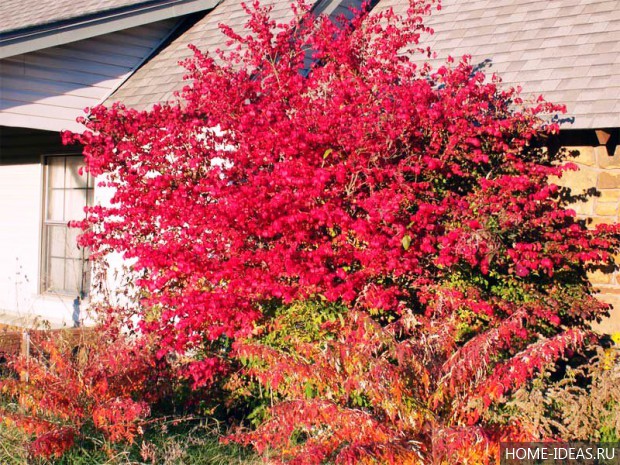



I would like to draw the attention of gardeners to the fact that seedlings for landscaping should be chosen taking into account the type of soil. Japanese quince loves warmth, but is quite unpretentious to the ground. Its decoration is not only small flowers and leaves, but also fruits. Thus, this modest bush will delight you with its flowering in spring, greenery in summer, and decorative berries in autumn.Dogwood grows well in moist soil. Its inflorescences are pleasantly fragrant, and the unusual color of the shoots gives a simple bush some kind of exoticism.
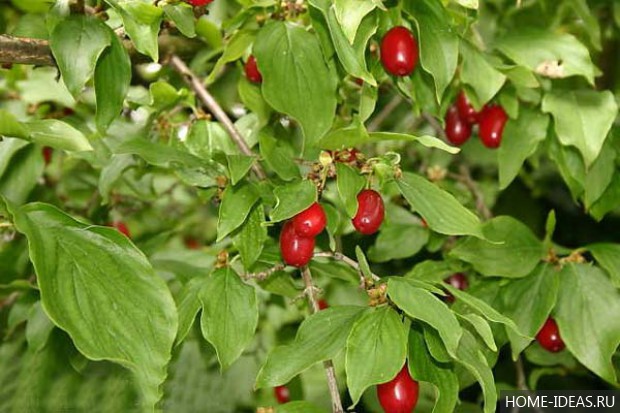
Depending on the variety, the color of the leaves may vary: from rich green with a light border to dark bronze. The beautiful forsythia blooms in early spring, when most of the trees have not yet woken up after winter. How fabulous this bush looks, covered with bright yellow flowers! And the requirements of this royal person are also high: fertile soil and moderate watering.For southern regions with sandy soil, the ideal inhabitant is tamarisk. And during the flowering period, you just can’t take your eyes off it!
Variety of colors in the area
Relatively speaking, according to the decorative value, shrubs can be divided into deciduous and flowering ones. Which type to choose - the solution to this issue depends on the desired effect.
To create a landscape composition, you need to know everything about the texture and color of leaves or needles. Let evergreen or ornamental bushes not seem boring to you. In beauty, they are in no way inferior to their flowering relatives. Well, how can someone not like the tart smell of juniper?
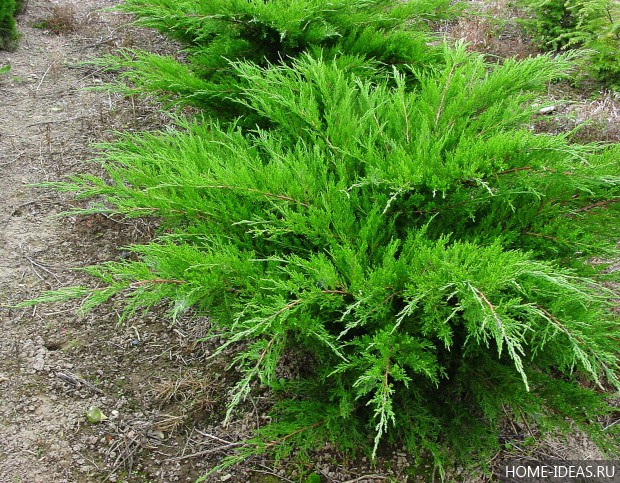
it coniferous plant is actively used both in topiary art and in the planning of park and country alleys. Beautiful evergreen shrubs for the garden - mahonia with dark-colored foliage and multi-colored panicles, or boxwood, which is simply made for curly haircuts.
The change of seasons can be observed by the color of some bushes. For example, vesicles change the color of the leaves: the Aurea variety throws out reddish leaves from the buds, at the beginning of summer they become almost orange, then slightly fade, and in autumn they explode in the color of bright gold. By the way, if you plant a vesicle in a shaded area, we get a consistently green tint. Barberry also gives a wide palette of colors.
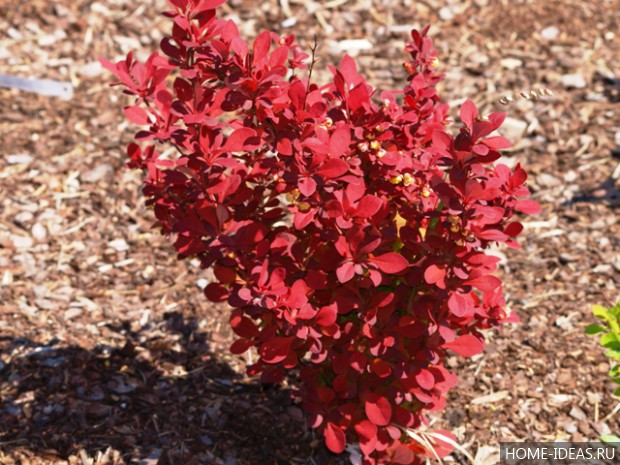
Depending on the type, the crown of the bush can be purple or golden, emerald or crimson. They look especially elegant along the low fences that separate the boundaries of the site.
A real fairy tale is flowering ornamental shrubs. The owners will be pleased with the riot of colors, the bees - with a wide scope for work. In early spring, lupus and forsythia are the first to bloom, then lush hats of viburnum and modest miniature bouquets of white turf bloom. Then we are intoxicated with aromas of jasmine bells and curly bunches of the queen of the Russian lilac garden. Broom and rhododendron, cinquefoil and spirea add beauty to our dachas.
Planting shrubs: general rules
As with any ornamental plants, plant and transplant garden bushes follows in the fall. The main thing is to make sure that the shrub has time to take root well before the onset of frost. First of all, you should choose a place to land.

Consider the type of shrub, as we have already discussed above. It is necessary to remove weeds and carefully remove the top layer of soil (especially if planting is done on a lawn). Next, we dig a hole. Its dimensions should significantly exceed the width of the root system. Try a seedling. The longest root should not be cramped in it.
The bottom of the pit and the walls must be loosened with a pitchfork to saturate the soil with oxygen. It is recommended to make compost or peat when planting, as well as add a slow-acting fertilizer.

Then put the seedling next to the peg, straighten all the roots, cover with earth. Firm the soil gently with your foot. Make a roller around the pit from the soil so that the water does not spread during irrigation, but goes right under the root. Water the seedling generously from above.
The planted shrub must be tied to a peg. This is done so that the root does not move, and in the future the plant stretches straight up. Apply a bandage of soft material at a height of about 30 cm from the ground.
Basic Care Tips
Contrary to popular belief, garden ornamental shrubs do not require careful maintenance. Forget the stereotype of the gardener, imposed by soap opera directors: in the park near the luxurious mansion, he spends days on end, cutting green shoots and relentlessly shaping the crowns of lush bushes.

In fact, plants need only periodic hilling and proper watering. Of course, it is necessary to cut off excess branches to give a well-groomed shape, and remove old shoots. Frost-resistant viburnum and lilac do not require preparation for the cold season. And roses, hydrangeas and rhododendrons need only be covered with reeds or spruce branches.
Photo selection
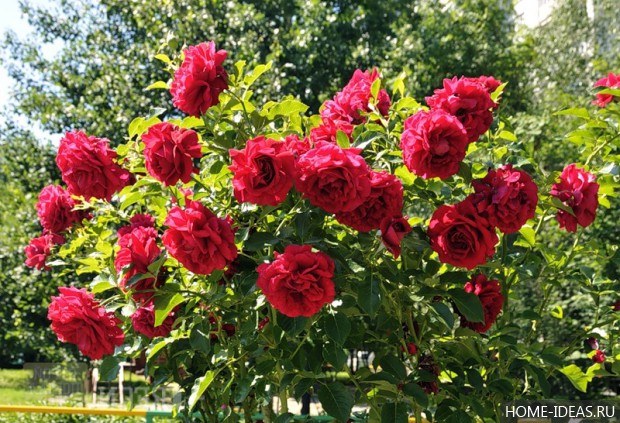


![]()

















![]()






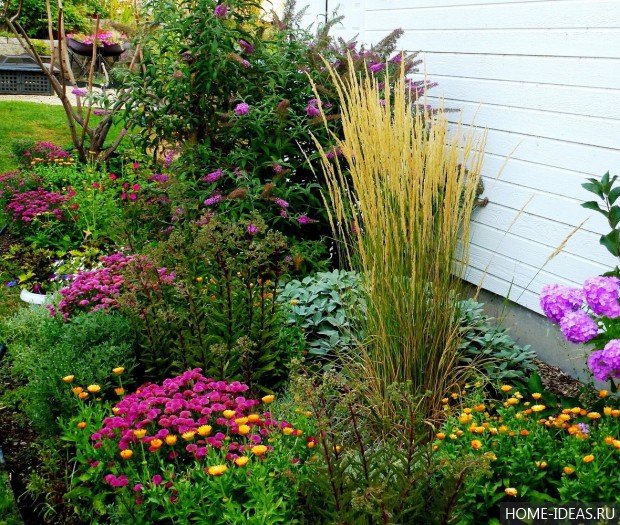





Video - care and cultivation of shrubs




















